Usage Guide
Information
 The Food Culture Museum comes with the functionality to transmit information on Obama City.
The Food Culture Museum comes with the functionality to transmit information on Obama City.Customize your own exploration map for sights in the city with "My Obama Promenade," and get the latest information directly with "Up to Date News from Wakasa Obama."
You can print your exploration map and hand it out, making it perfect for sightseeing, or as an introductory tool for far away friends to Obama.
Museum
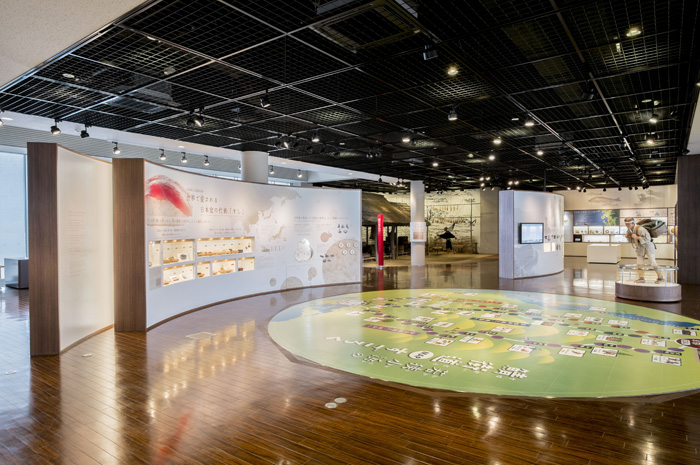 One of the first things that foreign tourists come to Japan for is to try out the local Sushi. Starting with our booth "Sushi, the model of world-loved Japanese cuisine," we are holding exhibitions dealing with many themes.
One of the first things that foreign tourists come to Japan for is to try out the local Sushi. Starting with our booth "Sushi, the model of world-loved Japanese cuisine," we are holding exhibitions dealing with many themes.We offer many replicas of reproduced foods, including a "New Year’s soup with rice cakes" that is eaten at the beginning of the year as a wish for a safe year, a "traditional roundtable event and feast," a staple of folk custom that introduces a year of Wakasa-Obama through food, "Japanese food" of UNESCO'S Intangible Cultural Heritage, and Japan's Heritage of "Miketsukuni-Wakasa and Saba Kaido."
| Open Dates and Times | 9:00~18:00(3/1~10/31) 9:00~17:00(11/1~2/end) |
| Closed |
Wednesdays (We are closed on holidays) New Year’s Holiday (12/28~1/5) |
| Fees | Free |
Kitchen Studio
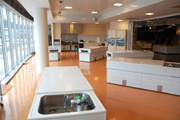 Go through cooking or manufacturing trials that use the freshest ingredients from Wakasa, or attend a lecture on food education. This is an activities center facility for food education that will last a lifetime. From children to senior citizens, we offer suggestions for food that meet a wide range of one's needs.
Go through cooking or manufacturing trials that use the freshest ingredients from Wakasa, or attend a lecture on food education. This is an activities center facility for food education that will last a lifetime. From children to senior citizens, we offer suggestions for food that meet a wide range of one's needs.
Cooking Trial *Reservation required
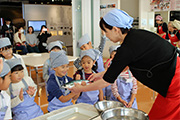 Use an abundance of ingredients from Obama and have fun making cuisine of the season in a group. You will be instructed by Group Mermaid, promoters for the betterment of eating habits in Obama City. Come here to make a delicious lunch or dinner. (Please apply with a group of four or more people.)
Use an abundance of ingredients from Obama and have fun making cuisine of the season in a group. You will be instructed by Group Mermaid, promoters for the betterment of eating habits in Obama City. Come here to make a delicious lunch or dinner. (Please apply with a group of four or more people.)| 【Ingredients used during cooking trial】 | |
| Ingredients used are primarily local. Non-manufactured items are all domestically-produced. | |
| Fees | 1,000 yen~/ per person |
| Usage Hours (For reference) |
10:00~13:00 14:00~17:00 18:00~21:00 |
| Other | * Tour contents change very month. * Tour contents can be changed at your request. Please consult with us. * For any other details, please let us know. |
Manufacturing Tour (Making Souvenirs) * Reservation required
| Fees | 600 yen~1,900 yen |
|
Hours (For reference) |
10:00~21:00 (Lasts approx. 1~2 hours) |
| Other |
* Fees and time schedule are subject to change depending on tour contents. * For any other details, please consult us. |
Borrow a Kitchen * Reservation required
| Fees | 500 yen / 1 countertop (3 hours) * Separate fees apply if using air conditioning. |
| Usage Hours (For reference) |
10:00~13:00 14:00~17:00 18:00~21:00 |
| Other | * Please arrange ingredients and seasoning yourself. * Please make note of the following.
|
Kitchen Supplies
Please use it for your various cooking.
Wakasa Workshop

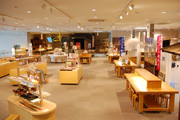 Throughout time, the traditional crafts of Wakasa Obama (Wakasa lacquer, Wakasa agate work, Wakasa Japanese paper, Wakasa roofing)have supported food history and culture. Here you can experience tradition through the sale of handicrafts made by workmen carrying on traditional craft, and the making of chopsticks and paper.
Throughout time, the traditional crafts of Wakasa Obama (Wakasa lacquer, Wakasa agate work, Wakasa Japanese paper, Wakasa roofing)have supported food history and culture. Here you can experience tradition through the sale of handicrafts made by workmen carrying on traditional craft, and the making of chopsticks and paper. | Open Dates and Times | 9:00~18:00(3/1~10/31) 9:00~17:00(11/1~2/end) |
| Closed | Wednesday (We are closed on holidays) New Year holiday (12/28~1/5) |
| Reception desk hours | 9:00~17:00(3/1~10/31) 9:00~16:00(11/1~2/end) |
Wakasa Lacquer
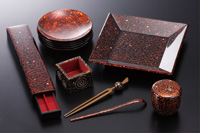 The history begins during the Keichou era (1596~1614), when the wealthy merchant Rokurosaemon Kumiya presented a lacquered box that he had acquired from outside the country to feudal lord Tadakatsu Sakai. Local craftsman Matsuura Sanjuuroo produced his own copy, making improvements and designing an undersea pattern that was contrived with Chrysanthemum coating. One of his pupils made a seaweed-patterned lacquering that represented shells of the beach and the beautiful scenery of white sand. In the Manji era (1658~1660), feudal lord Tadakatsu Sakai perfected the technique of using gold and silver foil eggshells and christened it "Wakasa Lacquer," inciting production as a key industry for the public finance of the Obama Domain and safeguarding it.
The history begins during the Keichou era (1596~1614), when the wealthy merchant Rokurosaemon Kumiya presented a lacquered box that he had acquired from outside the country to feudal lord Tadakatsu Sakai. Local craftsman Matsuura Sanjuuroo produced his own copy, making improvements and designing an undersea pattern that was contrived with Chrysanthemum coating. One of his pupils made a seaweed-patterned lacquering that represented shells of the beach and the beautiful scenery of white sand. In the Manji era (1658~1660), feudal lord Tadakatsu Sakai perfected the technique of using gold and silver foil eggshells and christened it "Wakasa Lacquer," inciting production as a key industry for the public finance of the Obama Domain and safeguarding it. In this way, he was welcomed by the warm care of successive feudal lords, which brought many craftsmen out and gave birth to the elegant design of Kikusui-Shioboshi.
In the first year of the Man'en era (1860), it is said that a Wakasa lacquered cabinet was presented occasion of the Imperial Princess Kazunomiya's marriage. Even up to the Meiji era, following the abolition of feudal domains and establishment of prefectures, it was promoted as a special product of Wakasa, and in its golden age there were 40 establishments producing implements, with 70 workers.
After World War II, many lost their jobs or were forced to change or close their business due to no sales resulting from lack of materials and consumers having no excess funds. Today, there are 7 establishments and 27 workers.
Since 1955 (Showa 30), production areas stabilized along with rapid economic growth, and with support of the purchasing power of firm consumers, it came into the spotlight as a specialty of Obama, and on February 6, 1978 the Minister of International Trade and Industry designated it a traditional artifact.
In addition, the NHK serial "Chiritotechin" from October, 2007 depicts the main character's father and grandfather as craftsmen for Wakasa lacquer, garnering it more attention than ever.
≪Characteristics of Wakasa Lacquer≫
Of all the lacquerware production areas throughout the country, "Wakasa Lacquer" uses a "polishing" technique that involves coating on many layers of lacquer. Wakasa Lacquer made over several months’ time by coating the finest lacquer some ten-odd times, applying a pattern with shells, eggshells, and gold leafs, and polishing it with stones and charcoal has a characteristic profoundness and character, and is widely used as furniture or appliance destined to be a family treasure.
Wakasa Agate Work
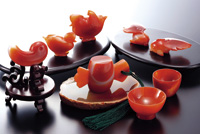 It is told that the beginning of Wakasa's agate work started during the Kyouhou era (1716~1735), a local of the area named Yoshibee Takajima set out for Naniwa (present-day Osaka) and learned how to craft spectacle rims at an optician, and started a business once he returned home.
It is told that the beginning of Wakasa's agate work started during the Kyouhou era (1716~1735), a local of the area named Yoshibee Takajima set out for Naniwa (present-day Osaka) and learned how to craft spectacle rims at an optician, and started a business once he returned home. Afterward, Heisuke Nakagawa worked diligently on further improving the skill up until the early Meiji era. Not being satisfied with only making lenses, he devised a variety of crafting and carving methods, while at the same time pioneering the market for his goods. He widely introduced the excellence of his work by submitting it to domestic and foreign fine art exhibitions, and was honored with an award each time. The reputation of Wakasa agate work gradually rose, earning praise not only domestically but far away overseas.
In 1905 (Meiji 38), in a search for raw ore, vendors used the opportunity of mining for it together in Hokkaido to collaborate on the improvement of the craft and accumulate research on design.
After World War II, depletion of ore in Hokkaido coupled with the introduction of commodity tax caused concern for the future of the production center, resulting in the loss of approximately 300 workers. However, with an appointment by the Minister of International Trade and Industry for traditional crafts on June 2, 1976 (Showa 51), several workers today are honing their skills in the scrupulous production of Bhuddist statues, animal ornaments, incense burners, vases, ash trays, broaches, earrings, pendants, rings, and necklaces
≪Characteristics of Wakasa Agate Work≫
Wakasa agate work is the root of precious stone work of our country. Since long ago, agate has been considered one of the seven treasures, and it's elegant and dazzling color tone is said to capture people's hearts.
The technique of breaking hard stone and carving a product to one's liking was born from a strict practice that doesn't allow even the smallest of mistakes. It wouldn't be an exaggeration to say that Wakasa agate works carved through unique technique is the pinnacle of precious stone arts.
Wakasa Japanese Paper
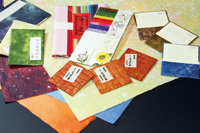 Japanese paper has a long history, going as far back as the Enryaku era (782~806), when the Tamura territory (present day Wadata district of Obama) was ruled by the Master of the Palace Table at Sakanoue no Tamuramaro's manor. It was around this time that the manufacturing technique of Japanese paper was passed down.
Japanese paper has a long history, going as far back as the Enryaku era (782~806), when the Tamura territory (present day Wadata district of Obama) was ruled by the Master of the Palace Table at Sakanoue no Tamuramaro's manor. It was around this time that the manufacturing technique of Japanese paper was passed down.The "Wakasa Chronicles" describes a "paper for Shuchuunan Sakumotsu tax" among the forms of offering of farm taxes, noting that around the Engi era (901~922)paper was sent from Wakasa to the capital as a form of tax. It is also recorded in the "Wakasa Prefecture Chronicles" that the paper would be made in what is present-day Yunooka in Obama, Wadata and Natashomie Oi.
It is said that during the rule of Obama's feudal lord Tadakatsu Sakai, his pushing for the cultivation of paper mulberry and oriental paperbush lead to thriving production, developing it as a craft done in one's own household. As a result of the social turning point of the early Meiji era, only a few households in the Wadata district carry on the traditional craft of paper-making.
≪Characteristics of Wakasa Japanese Paper≫
"Wakasa Japanese paper" made in Wakasa Obama, with its beautiful waters, uses carefully selected paper mulberry to create a pure and sturdy paper.
Originally, it was typically used as wrapping paper for silk cloth, and even the production of Japanese umbrellas, shoji paper, sandpaper, and Japanese sliding screens. Today, it is used as material to make designer paper, business cards, address books, and paper dolls.
Hama Hot Springs
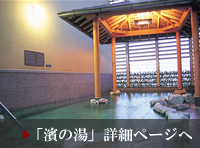 Eat well, be well. Hama Hot Springs is equipped with hot bath facilities that will heal the fatigue of your body and mind and allow you to relax. Enjoy a seaweed bath, Chinese herbal medicine bath, sauna, and a massage at our ocean view facility. You can also enjoy a foot bath (no charge) at the marine deck.
Eat well, be well. Hama Hot Springs is equipped with hot bath facilities that will heal the fatigue of your body and mind and allow you to relax. Enjoy a seaweed bath, Chinese herbal medicine bath, sauna, and a massage at our ocean view facility. You can also enjoy a foot bath (no charge) at the marine deck.
| Business Hours | 10:00~24:00(3/1~10/31) 10:00~23:00(11/1~2/end) |
| Closed | 3rd Wednesday of every month, maintenance (indeterminate) *The footbath is closed during the winter (December~Early April). |
| Fees | Adults (Middle school and above) 620 yen Childre (Elementary school and below) 310 yen *Children under 3 are admitted free of charge Senior citizens (70 and above), handicapped 520 yen Ticket Book (11 tickets) 6,200 yen |
Four Seasons of Hama
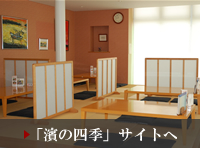 The Four Seasons of Hama is a facility for the provision of marine products. We provide only local ingredients, with a focus on traditional cuisine. Our staff is composed of local women groups. Enjoy Miketsukuni Wakasa Obama's slow food.
The Four Seasons of Hama is a facility for the provision of marine products. We provide only local ingredients, with a focus on traditional cuisine. Our staff is composed of local women groups. Enjoy Miketsukuni Wakasa Obama's slow food.








